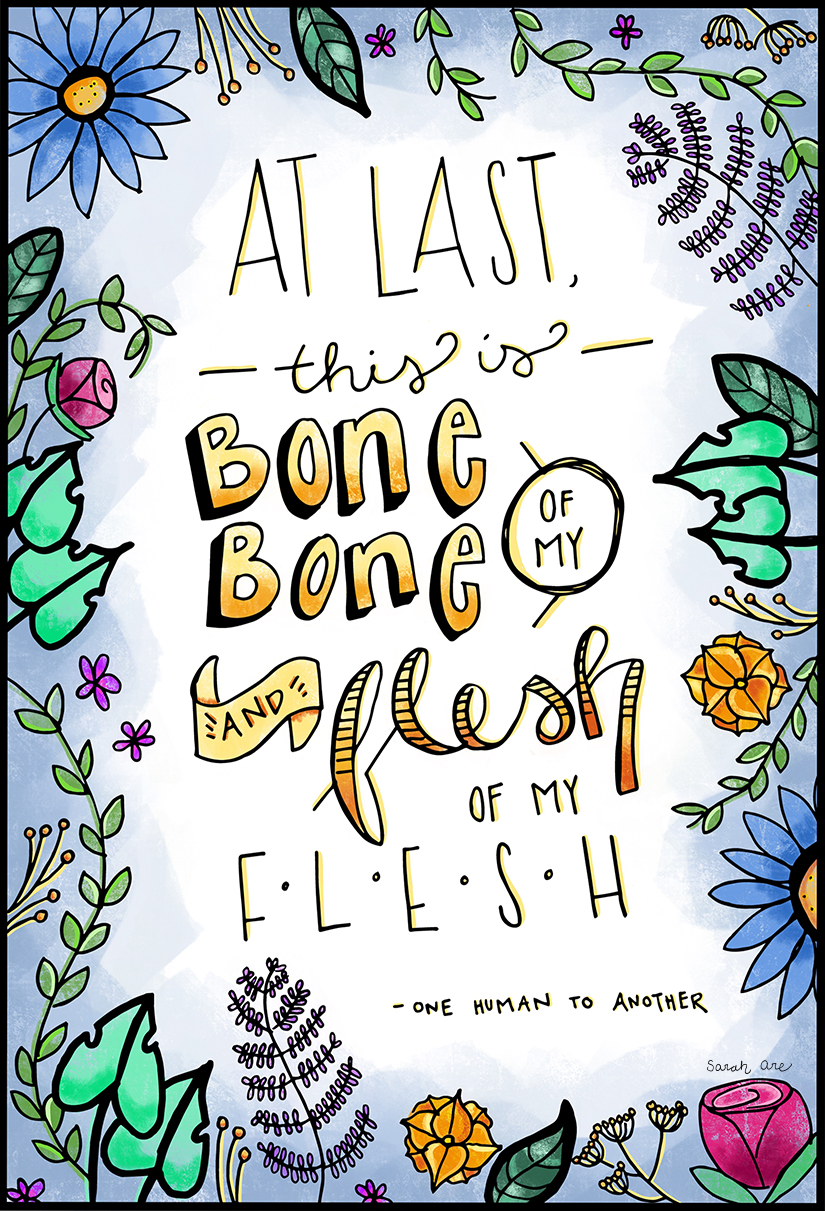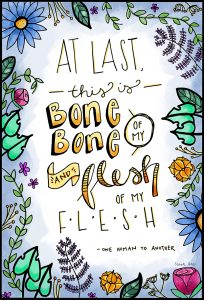
Belong: Why Me Means We
You and I are dirt creatures. Scripture describes us as dirt sculptures made alive by the spirit of God.
The Lord God formed the human (ha-adam) from the dust of the ground (ha-adamah), and breathed into his nostrils the breath of life; and the human became a living being. (Genesis 2:7)
The human (ha-adam) is formed from the earth (ha-adamah). There are two important words here: adam and adamah. The word adam is not a name, at least not yet and not here. And we clearly know that it is not a name here because the Hebrew says THE adam (ha means the). And no one (not even ancient Hebrew) goes around speaking the word THE before a proper name – The Jason or The Adam! So adam is not a name here.
The adam relates to the adamah. And adamah means earth, dirt, mud. Adam is a word that describes our origin. So, in Hebrew, adam literally means mud-creature (ie. human).
So, the human (adam) is formed from the earth (adamah). To help you understand better, think of it this way: the human is formed from the humus. That actually works well in our language! So, what happens next?
Well, God breathes the breath of life into the human. In Hebrew, God’s breath is called ruah. The word means breath and spirit. And this is incredible! God’s spirit moves into us. It animates us. It lives in us giving us life. The presence of God is, accordingly to Genesis, within us.
It’s not all that different from frosty the snowman. You know, you build a human form from snow, you give it facial features, and then something magical animates good old frosty! In the snowman’s case, it was an old silk hat. In our case, it’s the spirit of God.
So we are not just dirt creatures, we are dirt-spirit creatures. And this makes a difference in how we see ourselves and in how we see one another. We are, you and me and everyone else, dirt creatures filled with the spirit of God!
Now, there are a lot of assumptions we bring to this Genesis story. And I want to show you one.
Many people assume that here in Genesis 2 a man was created. We think of adam as a man’s name and we assume this first earth creature is a male. But the scripture does not say that. It says adam from adamah; human from humus. That’s it. No gender here, not at this point. No mention of male or female. In fact, at this point in the story, we have no way of knowing whether this human is male or female.
Next, God says, “It is not good that the human should be alone. I will make a helper which corresponds to this human as an equal.”
If you assume that the Adam is male then you would expect this helper to be feminine. However, the Hebrew word for helper in this verse is masculine! So even when God says I will make for you a helper, that helper is written of at this point using male language.
So, all we really know at this point is that God forms a dirt creature, makes it alive by breathing into it. Then decides that this creature should not be alone. So God sets out to make a helper for this creature who is going to be just like this creature, a copy of the original, completely equal.
This may not be how you have heard this story before, but brothers and sisters, this is what the Hebrew literally says! This is the story without our modern assumptions and presuppositions.
So you know what happens next, God picks up more dirt (adamah), forms more creatures (just like God had done before), and God brings them before the human. And the human gives everyone of them a name.
It’s a nice story. All the animals get introduced and the human names them. Except there’s one problem: a helper corresponding to the human as an equal was not to be found.
In other words, no matter how hard God tried to shape some more dirt into an equal helper, it just didn’t work out. Isn’t that weird? It’s kinda like God got it really good the first time he made the human, but somehow couldn’t seem to do it again a second time as good as the first!
You ever had that kind of experience? You do something once and it was just really great the first time. But then you try to do it again and you just can’t get it right like you did the first time? Kinda like beginners luck. Sometimes the artistic process is like that. That first original creation is so good because it naturally and with a fresh mind. And you try so hard to do it again, but the harder you try the worse it is. This happens to me a lot! And here is seems to happen to God.
What happens next is God gives up of making another creature from the dirt. Something about that just isn’t working. Instead, God tries to make a second human from the first human. And it is here in this act of making a second human that we first see the word for woman. And it is interesting that the woman is named first in verse 22:
And the Lord God built the rib which was taken from the human into a woman, and brought her to the human.

At last this is bone of my bones and flesh of my flesh.
The verse in Genesis continues:
This one is called woman for from man this one was taken.
Finally, we get the man and woman distinction.
And then there is an addition to the story, a sort of moral to the story if you will, kinda like Aesop’s Fables always has a moral which attempts to say what the story was about. Genesis says the moral is about why men and women leave their family of origin to become one flesh.
Together, men and woman are one flesh because in this story they literally started as one flesh. By joining together the man and woman reunite as best they can to be that original human created so beautiful and artistically by God from the dirt.
So nowadays, we read this story at marriages, and use it to speak about the bond of marriage. Jesus even uses it in his teaching about divorce in Matthew 19. But is this verse fundamentally about marriage?
Well, there is no mention of marriage in it. There are a couple of words for marriage that could have easily been used if it was intended to be about marriage. But they are not found in this passage. And honestly, we use this passage today to talk about marriage between two people and that simply was not the way marriage was practiced in the ancient world.
Read then bible! Most everyone in book of Genesis and through the Hebrew Bible has several wives! The truth is, a man didn’t just leave his father and mother a cling to one wife (gulp) . . . he clung to several wives. So, this is no simple teaching about monogamous marriage between a man and a woman. (Sorry to burst your bubble!) Marriage in the Old Testament is a lot more complicated than that! But my point is not about marriage. My point right now is that this passage doesn’t even mention marriage.
It’s kinda like what pastor Tim said last week when he spoke about 1 Corinthian‘s 13, the love chapter. We read it at weddings, but it wasn’t originally written to simply be about marriage. It is about human relationships.
So, what is this Genesis passage about? Well, first and foremost, I believe this passage is about being human (adam). That is, after all, how it starts out. Specifically, this passage is about being human in our relationships with one another. Humans – male and female humans – should view one another as the man speaks of the woman: bone of my bone and flesh of my flesh.
Me as God determines, was not good. Me needed We. And so as We is made, there is belonging. And We makes Me complete and whole. Think about our disciples mission statement. It is newly placed on our wall in the sanctuary: a movement for wholeness in a fragmented world. That is our work: making fragmentation whole. And Genesis says fragmentation happens when there is no We.
What makes We? When we see one another and treat one another as bone of my bone flesh of my flesh. Everyone should do this. Both males and females should see one another this way. As we go out in the world leaving our mothers and fathers to live our own lives, we should treat one another as bone of my bone and flesh of my flesh. And when we do this we embody the true humanity that God formed from dirt and made alive with the spirit.
Genesis 2 is about how we see one another, how we treat one another, how we should cling to one another, how we are to live together in a world that would divide and conquer us. We are to be one, unified because when we work together, serving as helpers to one another, we take up roles which God designed within us so that we are never alone.
Brothers and sisters, we are all bone of our bones, and flesh of our flesh, one human to another. Through flesh and bone, we are all connected. We are bound to one another as human beings through these physical bodies we inhabit. Together we are a unique and beautiful artistic creation of a good and loving God.
We are all made from the first human. Separated from the same flesh and blood and made to be equal helpers for one another through this life we live.
And each of us is infused with the same spirit of God that was breathed into that first human. And we should treat one another with respect because God’s spirit is in the other person.
My prayer for us this day is that we will commit anew to live lives in service to one another, seeing the spirit of God in one another – and that means both friends and enemies – and working constantly together across the entire world to be one flesh, one people, one body, the body of Christ.
Amen.
